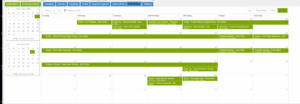Process, Process! It’s what Proposal Management is all about
Proposal management is about developing and submitting a compliant proposal on time; one that tells a compelling story of “why us.” If your company has been around for several years, you most likely have a well-established process in place. However, if you are just starting out, then that process might still be in flux. Even for those of you that have a well-established Proposal Management Plan, it may be valuable to occasionally re-evaluate its effectiveness. We have posted several articles about how DoD, and specifically the Air Force, has taken a new approach for some of its acquisitions and is moving towards a Rapid Acquisition strategy. If the Federal Government can explore better ways to ask for our services and products, then it may be beneficial for us to explore if we can improve our capture and proposal management processes, too.
Document Your Proposal Management Process

Proposal Management Scheduling can feel overwhelming without the right tools.
You may be surprised by how many companies do not have a formalized, documented Proposal Management Plan. There are two distinct advantages to documenting your proposal management process:
- First, it ensures consistency in how you manage each proposal effort. However, Government RFPs can sometimes throw you a curve ball, so leave room for flexibility.
- Secondly, reviewing the process in written form allows you to better understand where improvements can be made.
A good place to begin, if you’re looking for ideas, is to take a course on Shipley Proposal Writing. Many of us started there. Proposal scheduling is perhaps one of the most poignant aspects of proposal management that requires flexibility. No one can deny that the schedule is crucial to the success of the proposal. Setting up an effective proposal schedule is a balancing act. You begin with a Government RFP release and end it with the date and time that the proposal must be delivered. Everything else falls in between. And until that solicitation hits the street, you don’t really know when the beginning or the end is. Even after the RFP is released, the proposal due date can shift several times as amendments and extensions are posted. Here are some elements that should be included in your schedule for a typical proposal:
- Solicitation release date
- Meetings
- Internal kickoff
- Team kickoff
- Proposal team
- Final gate review or bid decision
- Writing assignments prior to each color team review
- distributed
- deadline and pens down
- Color Team Reviews
- Data calls
- sent out
- due back
- Pricing and other artifacts from subcontractors
- Production if submitted as hard copy
- Shipping or submission date
The list of schedule milestones likely varies from company to company, and Proposal Manager to Proposal Manager. However, the above list contains much of what the Proposal Management Plan would likely contain for a formal proposal. As mentioned earlier, the schedule is a balancing act. Subcontractors want to know when the kickoff will be held, but you want time to analyze the requirements so that you know what you need from them. Color team dates are crucial and can be incredibly tedious when you’re scheduling writing and editing assignments. Have you ever noticed how Contracting Officers (KOs) have a penchant for releasing Government RFPs right before major holidays so that they can come back to a clean desk? Regardless of how compressed your schedule is, or how much relief you received from that last amendment, it’s necessary to integrate the schedule with your proposal management of the specific opportunity. That is normally accomplished in one of the following ways:
- Send out a flurry of emails for each item on the schedule and then track individual responses in your inbox; or
- Send out a flurry of emails for each item on the schedule and then deal with teammates struggling to log in and navigate your portal.
Both methods get messy, result in missed data calls, and take a lot of time tracking down what has been sent out and received back by whom. There is a better way. Capture2Proposal (C2P) has integrated its scheduling and task management tools. With C2P you don’t have to spend time figuring out what has been sent out, who has responded, and who hasn’t. Here’s an example of a typical schedule laid out in C2P’s Scheduling feature:

Calendar Feature in the C2P
Now for the good stuff. Each item on the schedule is integrated into C2P’s Task Management feature. Here is what happens if I double click on any item in the schedule:

Customize the items you are scheduling down to the smallest detail.
You can send out, for example, a staffing data call. Recipients get an Outlook or Google compliant email, they download the template you send out, fill it out, and upload it. It’s automatically uploaded to your C2P repository for this opportunity, providing secure proposal collaboration in a virtual proposal center. To make the proposal management even easier, you can easily monitor the progress with C2P’s Task Management dashboard:

A screenshot of the task management page in the C2P app
What’s the takeaway? Remember these four points:
- Consider formulizing/documenting your Proposal Management Plan if you have not yet done so.
- If you have a formulized/documented Proposal Management Plan, re-evaluate it from time to time.
- Rarely do RFPs have exactly the same requirements; keep your Proposal Management Plan flexible.
- Consider using proposal management tools that allow you easily create your proposal schedule and that allows secure proposal collaboration for data calls, meetings, reviews, etc. as part of the tool’s functionality.

